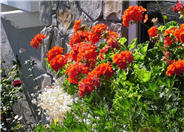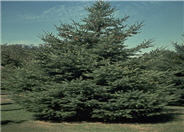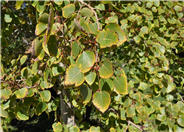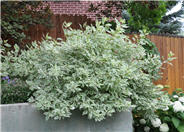
Common name:Garden Geranium
Botanical name:Pelargonium x hortorum
Garden Geraniums are shrubby, tender perennials that we grow as annuals due to their distaste of our cold winters. They come in a wealth of colors, both flowers and leaves. The flowers are actually clusters of lots of small flowers, blooming nearly all summer. The leaves are large, round, sometimes lobed, sometimes scalloped, typically green, though some have fabulous zones of red or mahogany, while others have white or other variegations. Many have a pleasant, musky scent. There are also ivy geraniums and scented geraniums; see those data sheets for more information.

Common name:White Spruce
Botanical name:Picea glauca
A broad, dense, pyramidal evergreen, valuable as a specimen, for massing, as a windbreak, or screen. The needles are green, with white undersides; the branches are ascending; and the cones between 1 to 2 1/2 inches long and pale brown. 30 to 60 feet tall and 20 or more feet wide; many varieties are available, with a variety of growth habits.

Common name:Western Water Birch
Botanical name:Betula occidentalis
Western Water Birch is a small tree or shrub, growing 20 to 30 feet tall and 15 to 20 feet wide. It tends to grow as a clump with upright, ascending branches. Leaves are oval, sharply pointed, prominently veined, and dark green. Fall color is yellow to orange. Spring catkins and small cone-like fruits mature in the fall and persist into winter, providing interest and forage for birds. Bark is smooth, reddish brown, with thin, cream lenticels (rather like a cherry tree). A Utah native.

Common name:Ivory Halo Dogwood
Botanical name:Cornus alba 'Bailhalo'
Ivory Halo is a smaller version of variegated dogwood, growing about 5 to 6 feet tall and wide, wide a compact rounded habit. Leaves are light green and white, and red in the fall. Bark is red and provides wonderful winter interest, especially when planted infront of evergreens or solid fences. It produces white flowers in late spring, which are followed by blue-white berries. Use in the shrub or foundation border, and combines effectively cotoneaster, hydrangea, spirea, viburnum, and wiegala.
| Designer: Ward and Child | WC Neighbor 5 |
Photographer: GardenSoft |
Water Saving Tip:
Fix leaking sprinklers, valves, and pipes.
One broken spray sprinkler can waste 10 gallons per minute - or 100 gallons in a typical 10 minute watering cycle.
